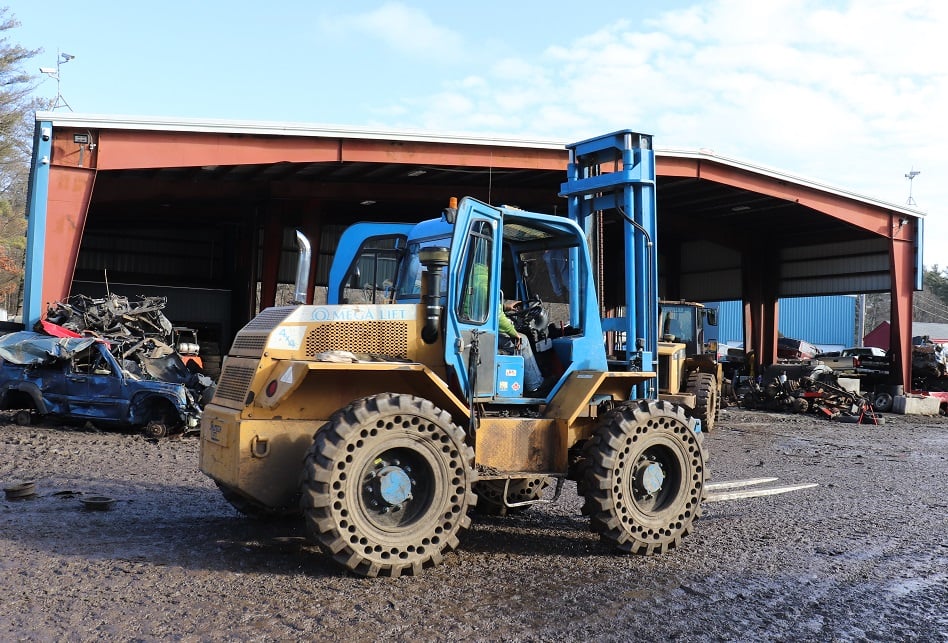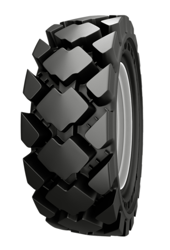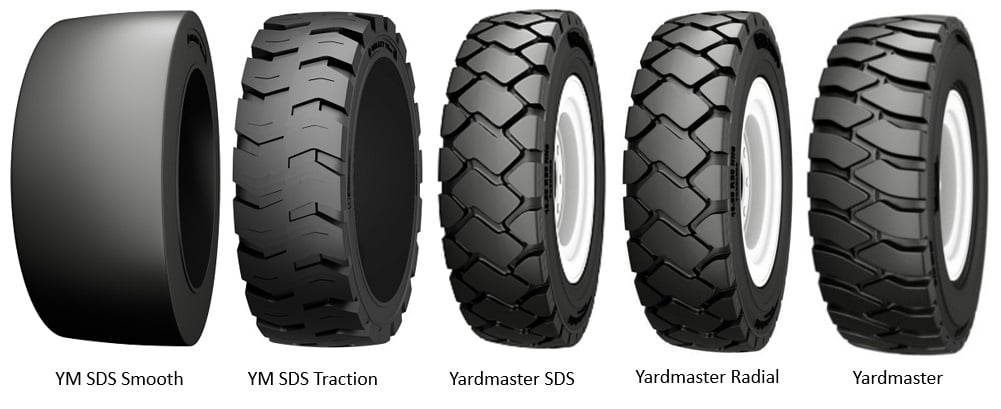New Forklift Tires Improve Productivity, Performance, and Safety
Tires play a vital role in the performance of forklifts—it’s estimated that the average drive tire on a forklift carries more than 9,600 lbs—and while it’s tempting to try and stretch the life of your forklift tires, doing so can lead to a host of issues. Conversely, if you replace forklift tires too early, you risk cutting into your return on investment. This begs the question: when is the right time to replace forklift tires?

When to Replace Forklift Tires
Forklifts are equipped with a handful of different types of tires—like resilient solid, press-on band, and pneumatic. Consequently, the tell-tale signs a tire is ready for replacement depend on the type of tire you’re using.
Resilient Solid Tires (Solid Pneumatics)
Resident solid tires make it easy to tell when it’s time to replace them—they’re manufactured with a 60J line, also called a “safety line,” on the sidewall that indicates when it’s time for new tires. Below that line, you could wear into non-tread types of compound, or structural plies and bead materials. While seemingly straightforward, knowing when to replace resilient solid tires can cause some confusion, especially with tires that have a pronounced tread pattern. In these cases, a tire doesn’t need replacement when the tread is worn smooth; rather, it requires replacement only when it has worn to the 60J line.
 It's worth noting that not all 60J lines are in the same place on a tire. For instance, the Galaxy Hulk SDS (Severe Duty Solid) on 16-inch rims features four times more usable rubber over the 60J line than comparable 20-inch tires from other manufacturers.
It's worth noting that not all 60J lines are in the same place on a tire. For instance, the Galaxy Hulk SDS (Severe Duty Solid) on 16-inch rims features four times more usable rubber over the 60J line than comparable 20-inch tires from other manufacturers.
It’s also a good idea to get in the habit of regularly inspecting resilient solid tires to ensure that damage like chunking or cracking doesn’t make them unserviceable.
Solid Press-On Band
When to replace solid press-on band tires depends on whether they’re smooth or feature a tread pattern. Smooth solid press-on band tires require replacement when one-third of the overall rubber has worn away. For tires with a tread pattern, you’ll want to use the tire’s 60J/safety line as a guide for replacement. Once the tire has worn to the line, it’s time for new tires. The “two-inch rule” is another method for judging if your forklift’s tires need replacement—if a tire has lost two inches or more from its original height, it’s ready for replacement.
In addition to the amount of rubber left on a solid press-on band tire, get in the habit of regular tire inspections. Chunking, cracking, tears, and flat spots can all signal that it’s time for replacement, even if it hasn’t worn away to two-thirds of its original height or down to the 60J line.
Pneumatics (Bias and Radial)
Pneumatic tires for forklifts are manufactured in two unique ways—bias and radial—each with its own strengths and weaknesses. One characteristic shared by the two types of pneumatic tires is the signs they show when they’re ready for replacement. Tread depth serves as a good guideline for how much life is left in a pneumatic tire; when a pneumatic forklift tire has no tread left, it should come out of service.
Regular inspection of pneumatic tires is important. Check tire pressure—underinflation can compromise stability and reduce fuel efficiency, overinflation will reduce stopping ability, and both will speed up wear—and look to make sure there’s no damage like cuts and punctures, which if they penetrate a pneumatic tire’s cords and plies means it’s new tire time. Similarly, signs of impact damage like bulges are also an indicator that it’s time for new tires.
How Many Forklift Tires Should I Replace?
In most instances, it’s unsafe to replace just one forklift tire. Mismatched forklift tires can cause a wide variety of problems, most notably instability, and can damage your forklift's drivetrain. When it’s time for new forklift tires, at a minimum replace both tires on the same axle.
Why to Timely Replace Forklift Tires
Operating a forklift with tires in need of replacement can cause a wide range of problems and, in many cases, can cost more money than simple replacement. Worn-out tires wreak havoc on a forklift’s productivity due to the increased risk of tire-related downtime and inefficient operation. They also pose a safety hazard, as subpar tires affect forklift stability and increase the odds of tip-overs and lost loads.
Because tires act as a suspension system for forklifts, they have an enormous influence over operator comfort. Machines with tires ready for replacement subject operators to more shocks and jolts, which can increase operator fatigue and result in less efficient operation and more mistakes. Those same shocks and jolts can also loosen hardware and lead to more maintenance. Additionally, well-worn tires can cause costly damage to a forklift’s forks, chains, and mast.
In addition to posing problems to your operation, operators, and equipment, tires ready for replacement are a threat to your facility. Tired drivers are more likely to run into racks, doors, and other infrastructure, while a lack of rubber can make machines more difficult to control.
Galaxy Yardmaster Range of Forklift Tires
Our expansive line of Galaxy forklift tires has an application-specific option for nearly every type of forklift and job they’re employed in. Our Galaxy Yardmaster range alone covers all types of forklift tires: press-on band, resilient solid, pneumatic radial, and pneumatic bias. Our press-on band Yardmaster is even available with either smooth or lugged treads and made with traditional and non-marking compounds.

When It’s Time to Pick Up New Tires
Tires also account for up to a third of fleet maintenance costs and choosing the right tire can have a significant effect on your bottom line. Work with your local dealer or Yokohama Off-Highway Tires representative to learn more about our Yardmaster range of forklift tires, find out more about the other forklift tires in our extensive lineup, and ultimately find the right tire for your forklift.


